This article needs additional citations for verification .(September 2014) |
The Propylaea (German : Propyläen) is a city gate in Munich at the west side of Königsplatz.
Contents

This article needs additional citations for verification .(September 2014) |
The Propylaea (German : Propyläen) is a city gate in Munich at the west side of Königsplatz.

The building, constructed in Doric order, was completed by Leo von Klenze in 1862 and evokes the monumental entrance of the Propylaea for the Athenian Acropolis. The gate was created as a memorial for the accession to the throne of Otto of Greece, a son of King Ludwig I of Bavaria.

As early as 1816, the Propylaea was in the early planning stages, but 30 years passed before the order was issued for its construction. Klenze painted a picture of the planned Propylaea, to promote the project. After King Ludwig I abdicated in 1848, the project was called into question, as, by that time, Munich no longer needed a city gate. Finally, Ludwig I financed the building from his private resources as a symbol of the friendship between Greece and Bavaria, as well as a monument to the Greek War of Independence. [1]
The Propylaea was opened shortly before King Otto was forced to resign as the Bavarian king of Greece. While on a visit to the Peloponnese in 1862, a coup was launched in Greece, a provisional Government was set up and a National Convention summoned . Ambassadors of the Great Powers urged King Otto not to resist, and the king and queen took refuge on a British warship and returned to Bavaria. It can be said that the Propylaea is also a monument to the failed secundogeniture of the Wittelsbach.

Each of the two towers of the gate is a powerful block with a large portal and an open room upstairs. The two portals of the towers were used for freight transport. The monumental gate in the middle of the Propylaea was reserved for riders and city cars. The ceilings of the towers were coffered.
While the exterior shows Doric columns, inside the structure, Ionic columns support the Propylaea. The floor plan shows that the basement of the building could be traversed by stairs, platforms and passageways.
The reliefs and sculptures celebrating the Bavarian prince and the Greek War of Independence were created by Ludwig Michael Schwanthaler.

Ludwig I or Louis I was King of Bavaria from 1825 until the 1848 revolutions in the German states. When he was crown prince, he was involved in the Napoleonic Wars. As king, he encouraged Bavaria's industrialization, initiating the Ludwig Canal between the rivers Main and the Danube. In 1835, the first German railway was constructed in his domain, between the cities of Fürth and Nuremberg, with his Bavaria joining the Zollverein economic union in 1834. After the July Revolution of 1830 in France, Ludwig's previous liberal policy became increasingly repressive; in 1844, Ludwig was confronted during the Beer riots in Bavaria. During the revolutions of 1848 the king faced increasing protests and demonstrations by students and the middle classes. On 20 March 1848, he abdicated in favour of his eldest son, Maximilian.
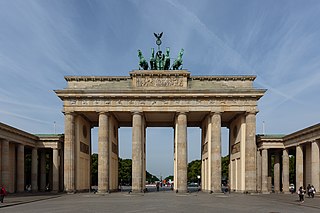
Greek Revival architecture was a style that began in the middle of the 18th century but which particularly flourished in the late 18th and early 19th centuries, predominantly in northern Europe, the United States, and Canada, as well as in Greece itself following its independence in 1832. It revived many aspects of the forms and styles of ancient Greek architecture, in particular the Greek temple. A product of Hellenism, Greek Revival architecture is looked upon as the last phase in the development of Neoclassical architecture, which was drawn from Roman architecture. The term was first used by Charles Robert Cockerell in a lecture he gave as an architecture professor at the Royal Academy of Arts in London in 1842.

The Englischer Garten is a large public park in the centre of Munich, Bavaria, stretching from the city centre to the northeastern city limits. It was created in 1789 by Sir Benjamin Thompson (1753–1814), later Count Rumford, for Prince Charles Theodore, Elector of Bavaria. Thompson's successors, Reinhard von Werneck (1757–1842) and Friedrich Ludwig von Sckell (1750–1823), advisers on the project from its beginning, both extended and improved the park.

Bavaria is the name given to a monumental, bronze sand-cast 19th-century statue in Munich, southern Germany. It is a female personification of the Bavarian homeland, and by extension its strength and glory.
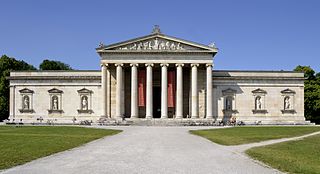
The Glyptothek is a museum in Munich, Germany, which was commissioned by the Bavarian King Ludwig I to house his collection of Greek and Roman sculptures. It was designed by Leo von Klenze in the neoclassical style, and built from 1816 to 1830. Today the museum is a part of the Kunstareal.

The Residenz in central Munich is the former royal palace of the Wittelsbach monarchs of Bavaria. The Residenz is the largest city palace in Germany and is today open to visitors for its architecture, room decorations, and displays from the former royal collections.

The Befreiungshalle is a neoclassical monument on the Michelsberg hill above the town of Kelheim in Bavaria, Germany. It stands upstream of Regensburg on the river Danube at the confluence of the Danube and the Altmühl, i.e. the Rhine–Main–Danube Canal. It is just downstream of the Danube Gorge, towering above its lower end. It was commissioned by King Ludwig I of Bavaria to commemorate the victory over Napoleon in the Befreiungskriege of 1813–1815.

Leo von Klenze was a German architect and painter. He was the court architect of Ludwig I of Bavaria.

St. Michael's is a Jesuit church in Munich, capital city of the state of Bavaria, Germany. It is the largest Renaissance church north of the Alps. The style of the building had an enormous influence on Southern German early Baroque architecture.

Königsplatz is a square in Munich, Germany. Built in the style of European Neoclassicism in the 19th century, it displays the Propyläen Gate and, facing each other, the Glyptothek and the Staatliche Antikensammlungen. The area around Königsplatz is home to the Kunstareal, Munich's gallery and museum quarter.

This article gives an overview about the architecture of Munich, Germany.

The Ludwigstraße in Munich is one of the city's four royal avenues next to the Brienner Straße, the Maximilianstraße and the Prinzregentenstraße. The avenue is named after King Ludwig I of Bavaria. The city's grandest boulevard still maintains its architectural uniformity envisioned as a grand street "worthy the kingdom" as requested by the king. The Ludwigstraße has served for state parades and funeral processions.

The neoclassical Brienner Straße in Munich is one of four royal avenues next to the Ludwigstraße, the Maximilianstraße and the Prinzregentenstraße. The boulevard was constructed from 1812 onwards, during the reigns of Maximilian I Joseph of Bavaria and his successor Ludwig I, in accordance with a plan by Karl von Fischer and Friedrich Ludwig von Sckell. The avenue is named after the Battle of Brienne.
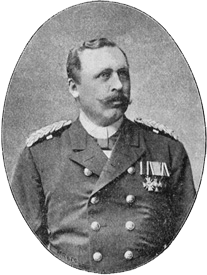
Eduard Riedel was a German architect and Bavarian government building officer. Among other things he is known for his contribution to the construction of Neuschwanstein Castle.

The Odeonsplatz is a large square in central Munich which was developed in the early 19th century by Leo von Klenze and is at the southern end of the Ludwigstraße, developed at the same time. The square is named for the former concert hall, the Odeon, on its northwestern side. The name Odeonsplatz has come to be extended to the parvis (forecourt) of the Residenz, in front of the Theatine Church and terminated by the Feldherrnhalle, which lies to the south of it. The square was the scene of a fatal gun battle which ended the march on the Feldherrnhalle during the 1923 Beer Hall Putsch.
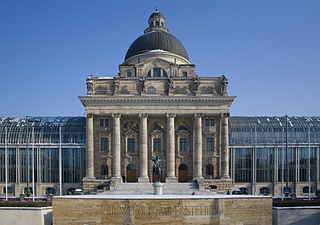
Bayerische Staatskanzlei is the name of a state agency of the German Free State of Bavaria and also of the appendant building.
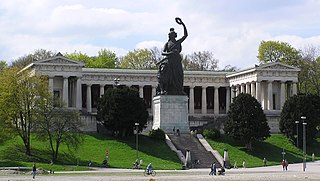
The Ruhmeshalle is a Doric colonnade with a main range and two wings, designed by Leo von Klenze for Ludwig I of Bavaria. Built in 1853, it is situated on an ancient ledge above the Theresienwiese in Munich and was built as part of a complex which also includes the Bavariapark and the Bavaria statue. It is built of Kelheim limestone and is 68 metres long and 32 metres deep.

The Palais Leuchtenberg, built in the early 19th century for Eugène de Beauharnais, first Duke of Leuchtenberg, is the largest palace in Munich. Located on the west side of the Odeonsplatz, where it forms an ensemble with the Odeon, it currently houses the Bavarian State Ministry of Finance. It was once home to the Leuchtenberg Gallery on the first floor.

The Palais Ludwig Ferdinand is an early 19th-century palace in Munich, Germany, designed by Leo von Klenze. It is located on the Wittelsbacherplatz but forms part of an ensemble with the buildings on the west side of the Odeonsplatz. It was Klenze's own residence, then belonged to Princes Alfons and Ludwig Ferdinand of Bavaria. It is now the headquarters of Siemens.

Bavaria is the female symbolic figure and secular patron of Bavaria and appears as a personified allegory for the state of Bavaria in various forms and manifestations. She thus represents the secular counterpart to Mary as the religious Patrona Bavariae.